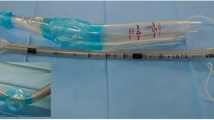Summary
CONTEXT: In addition to heart massage, the primary goal of cardiopulmonary resuscitation is efficient oxygenation and ventilation. OBJECTIVE: To compare the ease of learning and handling of standard mouth-to-mouth resuscitation with the Combitube (Tyco Healthcare Nellcor, Pleasanton, CA) ventilation. METHODS: After a 30 minute theoretical introduction and demonstration of mouth-to-mouth resuscitation and use of the Combitube in mannequins, following American Heart Association guidelines, 26 adolescent school children (15 of them 14 years old, 11 of them 10 years old) undertook two ventilation trials, each consisting of five single ventilations, with each technique. Only the second trial with each technique was evaluated. Qualitative implementation (grades: very good, good, failed) was evaluated, several procedure-related time points were recorded, and tidal volumes (ml) were measured. RESULTS: With mouth-to-mouth resuscitation, the time interval until start of first ventilation was 36.5 seconds shorter than with the Combitube (P < 0.001). With the Combitube, the time needed for five single ventilations was 6.4 seconds less than with mouth-to-mouth resuscitation (P < 0.001) and mean tidal volumes were higher (mouth-to-mouth resuscitation, 450 ± 384 ml, versus Combitube, 735 ± 358 ml; P < 0.05). CONCLUSION: Most of the school children performed both techniques to a high qualitative level. The study shows that mouth-to-mouth resuscitation and use of the Combitube have equal ease of learning, a precondition for proficient retention of skills. Tidal volumes were significantly higher with the Combitube and, not surprisingly, the time interval until the start of first ventilation was significantly shorter with mouth-to-mouth resuscitation. Regardless of the ventilation technique or device, we believe that subsequent retraining of ventilation skills is very important.
Zusammenfassung
HINTERGRUND: Neben der Herzdruckmassage ist die effiziente Oxygenierung und Ventilation ein vorrangiges Ziel bei der Herzlungenwiederbelebung. FRAGESTELLUNG: Vergleich der Einfachheit der Anwendung und der Erlernbarkeit der Standard Mund-zu-Mund-Beatmung und der Combitube-Beatmung (Tyco Healthcare Nellcor, Brunn am Gebirge, Österreich). METHODIK: Nach einer 30-minütigen theoretischen Einführung und Demonstration der Mund-zu-Mund-Beatmung und des Combitube an der Beatmungspuppe entsprechend den Richtlinien der American Heart Association (AHA), führten 26 Jugendliche (15 von ihnen 14 Jahre alt, 11 von ihnen 10 Jahre alt) zwei Beatmungsversuche à fünf Ventilationen mit jeder Technik durch, wobei nur der zweite Versuch ausgewertet wurde. Neben der Evaluierung der qualitativen Umsetzung (Benotung: sehr gut, gut, nicht genügend) wurden definierte Zeitspannen gemessen und die Tidalvolumina (ml) bestimmt. ERGEBNISSE: Die Dauer bis zum Beginn der ersten Ventilation war bei der Mund-zu-Mund-Beatmung um 36,5 Sekunden kürzer (P < 0,001). Die Zeitspanne bis zur Beendigung der fünften Ventilation war mit dem Combitube um 6,4 Sekunden kürzer (P < 0,001). Mit dem Combitube wurden signifikant höhere mittlere Tidalvolumina erreicht (Mund-zu-Mund-Beatmung, 450 ± 384 ml, versus Combitube, 735 ± 358 ml, P < 0,05). SCHLUSSFOLGERUNG: Die meisten Teilnehmer absolvierten beide Techniken qualitativ auf hohem Niveau. Diese Studie zeigt die vergleichbare Erlernbarkeit von Combitube und Mund-zu-Mund-Beatmung mit signifikant höheren Tidalvolumina für den Combitube und, nicht überraschend, eine signifikant kürzere Zeit bis zum Start der ersten Ventilation bei der Mund-zu-Mund-Beatmung. Die Autoren betonen allerdings, dass unabhängig von der Beatmungstechnik konsequentes manuelles Training äußerst wichtig erscheint.
Similar content being viewed by others
Author information
Authors and Affiliations
Corresponding author
Rights and permissions
About this article
Cite this article
Sherif, C., Erdös, J., Sohm, M. et al. Comparison of mouth-to-mouth resuscitation and Combitube ventilation in a bench model. Wien Klin Wochenschr 117, 769–775 (2005). https://doi.org/10.1007/s00508-005-0467-z
Received:
Accepted:
Published:
Issue Date:
DOI: https://doi.org/10.1007/s00508-005-0467-z




